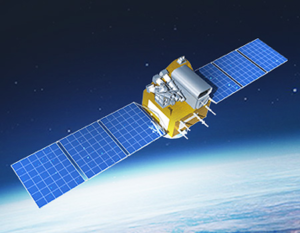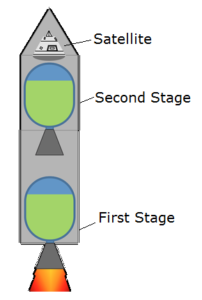Science > Physics > Gravitation > Satellites
In this article, we shall study about satellites, their types and uses of artificial satellites
Satellites:
Any object that revolves around a given planet in circular orbit under the influence of planet’s gravitational force is called as a satellite.

Types of Satellites:
Satellites are of two types. viz natural satellites and artificial satellites (man-made objects orbiting around the earth/planet). The moon is the natural satellite of the earth. The Earth, the Venus, and Jupiter are the natural satellites of the sun. INSAT-B, INSAT-IC are artificial satellites of the earth.
Projection of Satellite:
To launch a satellite in an orbit around the earth multistage rocket is used. The launching involves two steps. In the first step, the satellite is taken to the desired height and then in the second step, it is projected horizontally with the calculated speed in a definite direction. If the velocity is proper it starts revolving in a stable circular orbit.
To understand the launching of satellite let us consider a simple case of the use of a two-stage rocket. The satellite is kept at the tip of the two-stage rocket.

Initially, the first stage of the rocket is ignited on the ground so that the rocket is raised to the desired height, the first stage is detached. Then the rocket is rotated by remote control to point it in the horizontal direction. Then the second stage is ignited so the rocket gets push in the horizontal direction and acquires certain horizontal velocity (Vh). When the fuel is completely burnt second stage also gets detached and the satellite starts orbiting around the earth.

A Satellite is Placed Outside Earth’s Atmosphere:
The satellite orbiting very close to the earth’s surface has an orbital speed of about 8 km/s. As the height of the satellite from the surface of the earth increases its orbital velocity decreases. If the satellite is placed in the atmosphere, due to the high velocity of satellite and friction between the atmosphere and the satellite, large heat will be produced and the satellite will get burnt.
Types of Artificial Satellites:
Geostationary or Geosynchronous or Communication Satellite:
A communication satellite is an artificial satellite which revolves around the earth in a circular orbit in the equatorial plane such that,
- its direction of motion is the same as the direction of rotation of the ‘earth about its axis.
- its period is the same as the period of rotation of the earth, i.e. 24 hours.
When observed from the earth’s surface, this satellite appears stationary. Therefore, it is called a geostationary satellite. As its motion is synchronous with the rotational motion of the earth, it is called a geosynchronous satellite. The height of communication satellite above the surface of the earth is about 36,000 km.
e.g. INSAT series satellites, APPLE.
Notes:
- The orbit of the geosynchronous satellite is called geosynchronous orbit.
- It lies in an equatorial plane. i.e. the angle between geosynchronous orbit and equatorial plane is 0°.
- The radius of the geosynchronous orbit is about 42400 km.
- The satellite parking strip is an area over the equator is becoming congested with several hundreds of communication, weather, military and transmission satellites.
Uses of Communication Satellites:
- The communication satellites are used for sending microwave and TV signals from one place to another.

- The communication satellites are used for weather forecasting.

- The communication satellites are used for detecting water resource -locations and areas rich in ores.

- The communication satellites are used for spying In enemy countries i.e. It can be used for military purposes

Polar or Sun-synchronous Satellite:
A polar satellite is a low altitude satellite orbit around the earth in north-south orbit passing over the north pole and south pole. The orbit of the polar satellite is called the polar orbit. The polar orbit makes an angle of inclination of 90° with the equatorial plane. Polar satellites cross the equatorial plane at the same time daily.
The height of the polar satellite above the earth is about 500-800 km. Its time period is about 100 minute.

Advantages of Polar Satellite:
Geostationary satellites are fixed at one position w.r.t. the earth at height 36000 km above the Earth. Its long-range helps meteorologist to understand and analyze the weather. But to understand Earth’s atmosphere and changes in the atmosphere, the whole planet must be scanned periodically and most effectively. To this polar satellites are used.
Since its time period is about 100 minutes it crosses any altitude many times a day and its height h above the earth is about 500-800 km, a camera fixed on it can view only small strips of the earth in one orbit. Adjacent strips are viewed in the next orbit so that in effect the whole earth can be viewed strip by strip during the entire day. From the path shown in the figure, we can see that it covers almost all geographical area.

These satellites can view polar and equatorial regions at close distances with good resolution.
Information gathered from such satellites is extremely useful for remote sensing, meteorology as well as for environmental studies of the earth.
Uses of Polar Satellites:
- Information gathered from polar satellites is extremely useful for remote sensing, meteorology as well as for environmental studies of the earth.
- They are used for spying and surveillance.
- They are used for monitoring troop movements i.e. for military purpose.
- They are used to note land and sea temperature variation.
- They are also used to monitor the growth of crops.
Weightlessness in Satellite:
By the definition, the weight of a body is equal to the gravitational force with which the body is attracted towards the centre of the earth. When the astronaut is on the surface of the earth, his weight acts vertically downwards. At the same time, the earth’s surface exerts an equal and opposite force of reaction on the astronaut. Due to this force of reaction, the astronaut feels his weight.
When the astronaut is in an orbiting satellite, a gravitational force still acts upon him. However, in this case, both the astronaut as well as the satellite are now attracted towards the earth and have the same centripetal acceleration due to gravity at that place.
As both astronaut and the surface of the satellite are attracted towards the earth centre with the same acceleration, and hence the astronaut can’t produce any action on the floor of the satellite. So the floor does not give any reaction on the astronaut. Hence the astronaut has a feeling of weightlessness. When we are moving down in accelerating lift, we can have the feeling of partial weightlessness.
Actual Weightlessness Condition:
As we go away from the earth’s surface, the acceleration due to gravity decreases. At some point in space, it becomes negligible. At such points in space, weightlessness can be experienced. The acceleration due to gravity is zero at the centre, hence at the centre of the earth, weightlessness can be experienced.
Under free fall of the body, weightlessness can be experienced. Weightlessness can be experienced at some point between the Earth and the Moon where the gravitational field created by them cancel each other.
Effect of Weightlessness Condition:
- One can lift a load of 1000 kg easily.
- One can overturn coffee mug without spilling the coffee in it on the ground.
- It leads to a headache and puffy faces.
- The height can grow by 1 mm to 2 mm.
- The cardiovascular system does less work.
- The muscle can get out of condition, and consequently one may have difficulty in doing routine work after returning back to the earth.
Previous Topic: Numerical Problems on Keppler’s Laws
Next Topic: Critical Velocity and Period of Satellite